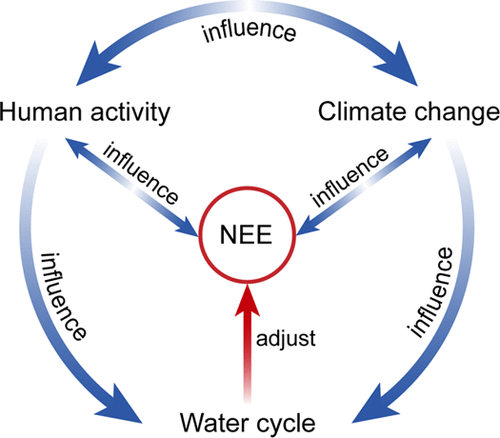当前位置:
X-MOL 学术
›
ACS Earth Space Chem.
›
论文详情
Our official English website, www.x-mol.net, welcomes your feedback! (Note: you will need to create a separate account there.)
How Carbon Footprint Responds to Water Circulation Rates and Availability at Different Timescales in a Subtropical Forest Ecosystem
ACS Earth and Space Chemistry ( IF 3.4 ) Pub Date : 2020-12-30 , DOI: 10.1021/acsearthspacechem.0c00289 Yao Lu 1, 2 , Yang Gao 1, 2 , Kun Sun 1, 2 , Sidan Lyu 1 , Xuefa Wen 1, 2 , Junjie Jia 1, 2 , Zhaoxi Li 1, 2 , Shuoyue Wang 1, 2
ACS Earth and Space Chemistry ( IF 3.4 ) Pub Date : 2020-12-30 , DOI: 10.1021/acsearthspacechem.0c00289 Yao Lu 1, 2 , Yang Gao 1, 2 , Kun Sun 1, 2 , Sidan Lyu 1 , Xuefa Wen 1, 2 , Junjie Jia 1, 2 , Zhaoxi Li 1, 2 , Shuoyue Wang 1, 2
Affiliation

|
In the subtropics, the influence of water on the net ecosystem carbon exchange (NEE) is critical, subsequently determining net primary productivity (NPP). Water also contributes the majority of interannual variability in atmospheric carbon dioxide (CO2) concentrations in the subtropics and helps to mitigate climate change. Using the technology of vorticity correlation, this study continuously monitored NEE, ecosystem respiration (RE), and the gross ecosystem exchange (GEE) of a small subtropical watershed in the middle and lower reaches of the Yangtze River from 2014 to 2017. Water parameters were concurrently monitored, such as rainfall (RF), runoff (RO), evapotranspiration (ET), vapor-pressure deficit (VPD), and soil water content (SWC). Results showed that an increase in the water circulation rate and water availability will promote an increase in GEE, RE, and NEE on both hourly and daily timescales, but will inhibit these carbon (C) exchanges on an annual timescale. For years that experience low annual rainfall but increased continuous rainfall, a decrease in ET may inhibit plant respiration, thus enabling subtropical forest ecosystems to fix more C. Additionally, more intense and irregular rainfall patterns caused by climate change may weaken the overall C sequestration capacity of subtropical forest ecosystems. Results from this study are intended to help us better understand coupled C and water cycling mechanisms within terrestrial ecosystems, while also providing a reference to assess the impact of climate change on ecosystem C cycling processes.
中文翻译:

亚热带森林生态系统中碳足迹如何在不同时间尺度上响应水循环速率和可用性
在亚热带地区,水对生态系统净碳交换(NEE)的影响至关重要,从而决定了净初级生产力(NPP)。水也是大气中二氧化碳(CO 2)集中在亚热带地区,有助于缓解气候变化。使用涡度相关技术,本研究连续监测了2014年至2017年长江中下游小亚热带流域的NEE,生态系统呼吸(RE)和总生态系统交换(GEE)。水参数为同时进行监测,例如降雨(RF),径流(RO),蒸散量(ET),蒸汽压差(VPD)和土壤含水量(SWC)。结果表明,水循环速率和可用水量的增加将促进小时和每日时标上GEE,RE和NEE的增加,但会抑制年度时标上的这些碳(C)交换。多年来,年降雨量少但连续降雨增加,ET的降低可能会抑制植物的呼吸作用,从而使亚热带森林生态系统能够固定更多的碳。此外,气候变化导致的更强烈和不规则的降雨模式可能会削弱亚热带森林生态系统的总体固碳能力。这项研究的结果旨在帮助我们更好地了解陆地生态系统中的碳和水循环耦合机制,同时也为评估气候变化对生态系统碳循环过程的影响提供参考。
更新日期:2021-01-21
中文翻译:

亚热带森林生态系统中碳足迹如何在不同时间尺度上响应水循环速率和可用性
在亚热带地区,水对生态系统净碳交换(NEE)的影响至关重要,从而决定了净初级生产力(NPP)。水也是大气中二氧化碳(CO 2)集中在亚热带地区,有助于缓解气候变化。使用涡度相关技术,本研究连续监测了2014年至2017年长江中下游小亚热带流域的NEE,生态系统呼吸(RE)和总生态系统交换(GEE)。水参数为同时进行监测,例如降雨(RF),径流(RO),蒸散量(ET),蒸汽压差(VPD)和土壤含水量(SWC)。结果表明,水循环速率和可用水量的增加将促进小时和每日时标上GEE,RE和NEE的增加,但会抑制年度时标上的这些碳(C)交换。多年来,年降雨量少但连续降雨增加,ET的降低可能会抑制植物的呼吸作用,从而使亚热带森林生态系统能够固定更多的碳。此外,气候变化导致的更强烈和不规则的降雨模式可能会削弱亚热带森林生态系统的总体固碳能力。这项研究的结果旨在帮助我们更好地了解陆地生态系统中的碳和水循环耦合机制,同时也为评估气候变化对生态系统碳循环过程的影响提供参考。



























 京公网安备 11010802027423号
京公网安备 11010802027423号